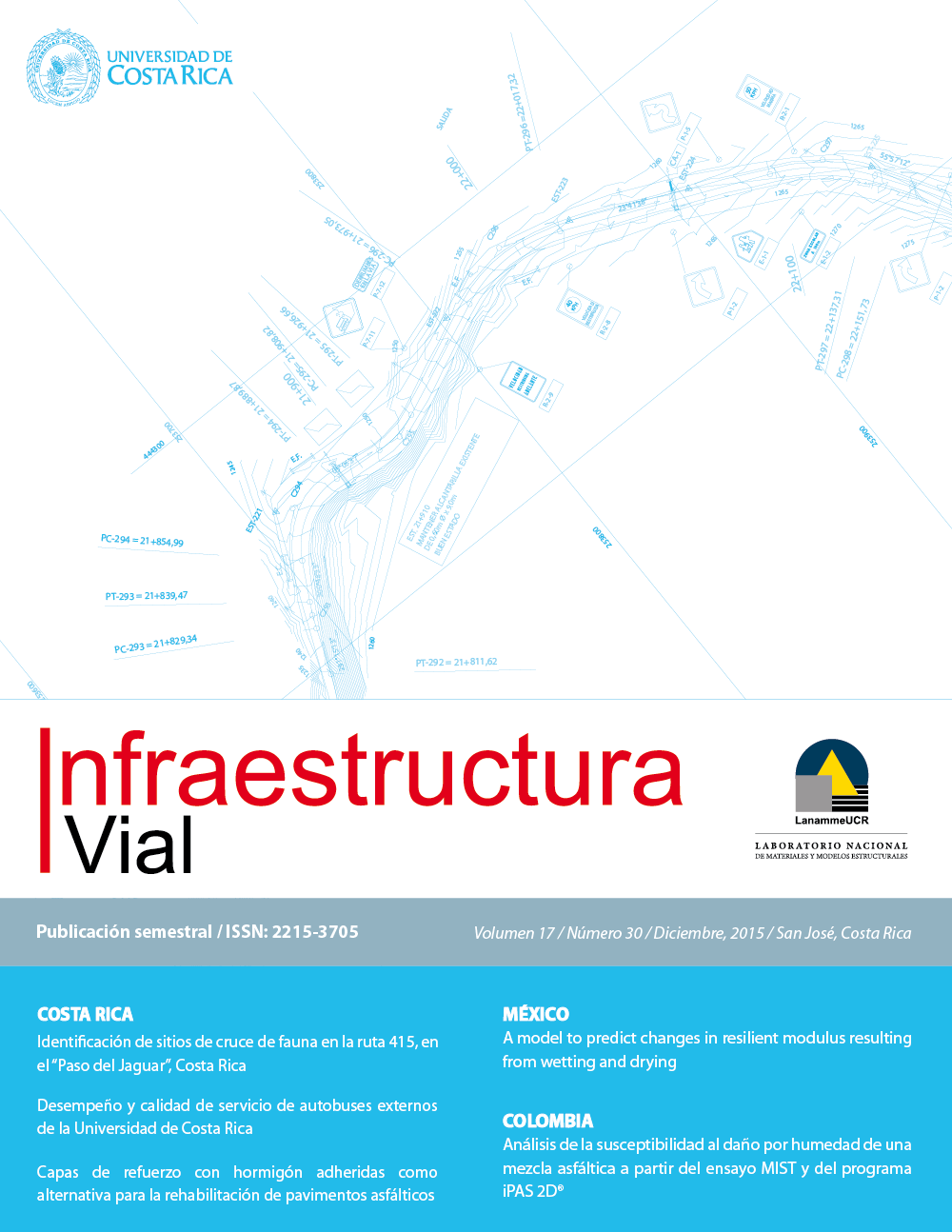Abstract
The main objective of this study, is to present basic considerations while designing a concrete overlay as a rehabilitation alternative for existing pavements. First, the pavement condition has to be evaluated by determining the type of damage, previous repairs, and the need for surface preparation; then it is necessary to evaluate the possibilities for the application of this technique. Bonded concrete overlays are a sustainable strategy to preserve and extend the life of pavements that can be used as minor rehabilitation, which its main purpose is to add structural capacity and to eliminate surface damage on existing pavements by creating an adequate bond between the concrete overlay and the pavement structure. High deterioration levels have been identified on pavement structures in Costa Rica, which make up most of the roads in the national road network, where quite often feasible solution alternatives are not considered due to a lack of knowledge. Therefore, this literature review focuses on the use of bonded concrete overlays, considering the construction requirements, as well as the design methodologies. This paper intends to provide road engineers with a reference document to help in deciding the most adequate solution to common problems found on existing pavements, in order to increase knowledge in this area, to encourage the use of new techniques to improve road infrastructure, therefore improve the quality of service provided to the user.
References
Abascal, J. (2013). Refuerzos con hormigón de pavimentos bituminosos. Instituto Español del Cemento y sus Aplicaciones (IECA). Madrid, España.53-1˚, 11.
ASTM D6433-11. (2011).Standard Practice for Roads and Parking Lots Pavement Condition Index Surveys. ASTM International, West Conshocken, PA.doi: 10.1520/D6433-11.
Autret, P., yBrousse, J.(1992).VIZIR Método con ayuda de computador para la estimación de necesidades en el mantenimiento de una red carretera. Laboratoire Central des Ponts et Chaussées, Paris, Francia.
Barrantes, R., Sanabria, J., Chacón, M., y Loría, G.(2015). Informe de Evaluación de la Red Vial Nacional Pavimentada de CostaRica, Años 2014-2015. Montes de Oca, San José, Costa Rica: Universidad de Costa Rica. INF-PITRA-001-2015, 40-47
Bordelon, A., y Roesler, J. (2012). Design with Fiber Reinforcement for Thin Concrete Overlays Bonded to Asphalt. Journal of Transportation Engineering. 430-433. doi: 10.1061/ (ASCE) TE.1943-5436.0000339, 430-435.
Coronado, J. (2002). Manual Centroamericano para Diseño de Pavimentos. Secretaría de Integración Económica Centroamericana. USAID/SIECA No. 0596-0184.20. Guatemala.
Han, C. (2005). Synthesis of Current Minnesota Practices of Thin and Ultra-Thin Whitetopping. Minnesota Department of Transportation. Research Services Section. MN/RC-2005-27, 1-17.
Harrington, D., Rasmussen, R., yTorres, H. (2011). National Concrete Pavement Technology Center. Design of Concrete Overlays Using Existing Methodologies. National Concrete Pavement Technology Center. FHWA, 1-11.
Harrington, D.,y Fick, G. (2014).Guide to Concrete Overlays: Sustainable Solutions for Resurfacing and Rehabilitating Existing Pavements. National Concrete Pavement Technology Center. Report No. ACPA TB021.03P. 3rd Edition. Washington, DC.
Mack, J.W., Cole, L.W.,y Mohsen, J.P. (1993). Analytical considerations for thin concrete overlays on asphalt. Transportation Research Record No.1388. Washington, D.C.
McGhee, K. (1994). Resurfacing. Synthesis of Highway Practice 204: Portland Cement Concrete. Washington, D.C. Transportation Research Board. National Research Council.Washington, D.C.
Miller, J., y Bellinger, W. (2003).Distress Identification Manual for the Long-Term Pavement Performance Program. Fourth Revised Edition. Report No. FHWA-RD-03-031. Washington, D.C.
Rasmussen, R. O. y D. K. Rozychi. (2004). Thin and Ultra-Thin Whitetopping. NCHRP Synthesis of Highway Practice 338, National Cooperative Highway Research Program, National Research Council Washington, D.C., 3-42.
Silfwerbrand, H., Beushausen, H.,yCourard, L. (2011). Bond. En Bissonnette, J. et al. Bonded Cement-Based Material Overlays for the Repair, the Lining or the Strengthening of Slabs or Pavements. RILEM State of the Art Reports. Springer Netherlands. 3(1), 51-79. doi:10.1007/978-94-007-1239-3.
Tia, M., Wu, C.L., Tapia, P.,y Kumara, M.A.W. (2007). Evaluation of Feasibility of Using Composite Pavements in Florida by Means of HVS Testing. Department of Civil and Coastal Engineering, College of Engineering, University of Florida, Gainesville, Florida, USA.
Trevino, McCullough, F., y Fowler, D. (2003).Techniques and Procedures for Bonded Concrete Overlays. Center of Transportation Research, Report No. FHWA/TX-05/0-4398-2, 21-118.
Vandenbosshe, J., N. Dufalla y Z. Li. (2012).A Revised Thin and Ultra-Thin Bonded Whitetopping Design Procedure. Presented at 2013 TRB Annual Meeting.
Vandenbossche, J. M.y S. Sachs (2013). Rehabilitation Strategies for Bonded Concrete Overlays of Asphalt Pavements. FHWA Pooled Fund stufy, TPF 5-165.
W. K. Mampearachchi, J. V. Kosgolla., y M.Tia. (2012). Feasibility of whitetopping for resurfacing thin asphalt pavements. Journal of the National Science Foundation of Sri Lanka,40(4), 293-302.



